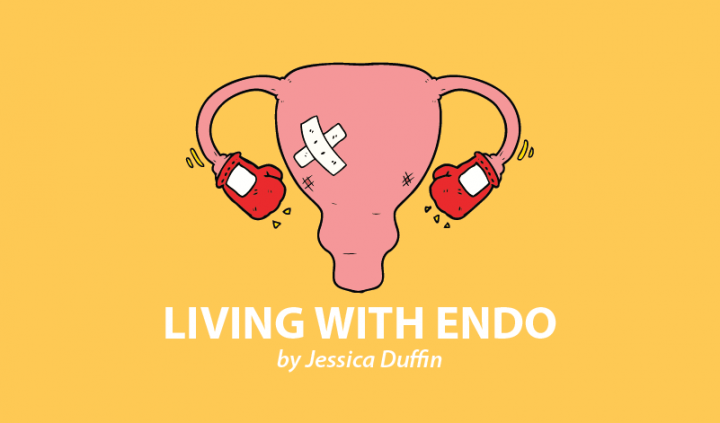It’s Mental Health Awareness Week in the United Kingdom. You may not be in the U.K., but that doesn’t make mental health any less important.
For me, the biggest toll of endometriosis, by far, has been on my mental health. My continuous run-ins with anxiety, depression, and eating disorders (believe it or not, it was endo bloat that triggered my 11-year eating disorder) have caused me to change careers twice and lose days, months, and years to sadness and worry. I’ve done my best to work through them, and I’m thrilled to say that I’m now in a place where I continue to move forward mentally — thanks to changing my work life, supporting my well-being, and seeking various supports.
The numerous types of therapies I’ve undergone over the years are no secret. I’ve discussed openly the cognitive behavioral therapy, psychotherapy, hypnotherapy, and counseling I’ve sought in an attempt to feel better. While all of these have served me in many ways, in more recent years, I’ve found the most healing support has come from more holistic and alternative therapies.
Many alternative therapies work on releasing energy and trauma from the body that may have manifested over the years. Of course, it’s important to talk about our struggles or mental health issues with a professional or take medication in cases when it’s necessary. But I’ve found that it’s important to treat the rest of the body, too. I’m not completely sure why that strategy has helped me. Maybe the physical body holds onto stress and emotional pain within organs or areas with disease. Or maybe it’s mentally unhealthy to have a blockage in the energetic body, the chakras. Maybe you could call me a believing skeptic. But what I can say is that I’ve found enormous peace and healing from the following therapies, and I know so many others who have as well. There’s a reason the wellness industry is booming, and it’s not just down to good marketing.
Reiki
I’ve had reiki a few times in the past, and it’s always been, in short (and I apologize for sounding cliché), a bit magical.
In a reiki session, a practitioner places his or her hands on or over the body and clears stagnant, blocked, negative energy that has built up. The practice is a form of relaxation, but the removing of these energies enables the body to begin self-healing again.
The first time I had reiki, I was deeply struggling with depression and acute anxiety. While lying there, I felt a drawing sensation moving up my body and into my head. Many people report the sessions as being deeply relaxing, but I had lots of negative feelings come up, then clear. I felt it was as if my subconscious was dragging it all up and out.
Since then, I’ve had it on odd occasions, and I always emerge feeling lighter and a little less captive to my depressive and anxious thoughts. Personally, I feel that reiki serves me best, but you have to go with what feels right for you.
Sound bath healing
I’m new to this, but I’ve always been very responsive to sound. Music, of course, is known for helping us process or release emotions, whether that’s crying our hearts out to a sad song or releasing negativity with dancing.
Sound baths are one type of increasingly popular sound therapy. I went to my first sound bath just the other week, and it left me feeling energized and relaxed at the same time. During a sound bath, therapeutic instruments such as crystal bowls, Tibetan singing bowls, and gongs are played while (usually) the listener lays down under some cozy blankets. This isn’t just relaxing because it sounds nice — these sounds actually activate the brain waves (alpha and theta) known to be present during meditation and REM sleep. These brainwave frequencies are thought to allow the subconscious to emerge forward, enabling healing on a deeper level.
TRE therapy
TRE, or tension and trauma release exercises, is a relatively new type of healing that I hear about more and more in London. In fact, I’ve not heard one person talk badly about it — it’s always explained to me with the utmost enthusiasm by the people who have tried it.
TRE involves specific repetitive exercises that trigger muscles into shaking to release tension, stress, and trauma that’s been building in our physical body. The method is based on scientific research. You can find out more about it here.
I’m trying this for the first time soon, and am excited to report back!
There are many other forms of alternative therapies that could help you deal with mental health issues often sparked by endometriosis. What have you tried?
***
Note: Endometriosis News is strictly a news and information website about the disease. It does not provide medical advice, diagnosis, or treatment. This content is not intended to be a substitute for professional medical advice, diagnosis, or treatment. Always seek the advice of your physician or other qualified health provider with any questions you may have regarding a medical condition. Never disregard professional medical advice or delay in seeking it because of something you have read on this website. The opinions expressed in this column are not those of Endometriosis News or its parent company, BioNews Services, and are intended to spark discussion about issues pertaining to endometriosis.


